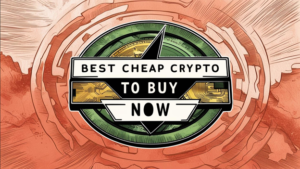STM Report Envisions Trillions Migrating to On-Chain Assets

The tokenization trend continues to ramp up in the cryptocurrency market as crypto prices enjoy an uptrend. Security Token Market (STM) noted in its latest report how, after ICOs and NFTs, the market is now seeing a much larger application and opportunity for blockchain technology in the form of “the tokenization of real-world assets.”
“We’re more confident than ever that over time trillions of dollars worth of assets will come on-chain,” said the report.
This emerging trend has been attracting interest from major players in the traditional financial (TradFi) space. Earlier this month, HSBC Holdings launched a platform to tokenize ownership of physical gold held in its London vault, while UBS Asset Management launched a pilot of a tokenized money market fund on Ethereum. Recently, Citi introduced Token Services to tokenize clients’ deposits so they can be instantly sent anywhere in the world.
Then there’s banking giant JPMorgan’s blockchain arm Onyx tapping an Avalanche subnet in a proof-of-concept with Apollo Global and the Monetary Authority of Singapore’s Project Guardian to “allow a portfolio manager to manage a large number of discretionary portfolios comprising tokenized assets across multiple blockchains.”
Most recently, the bank offered more programmability to institutional clients over its payment offerings on its blockchain-based accounts with the JPM Coin system. It has also been exploring on-chain digital wallets to enable users to store and control digital identity on its platform.
Just this week, Standard Chartered Bank’s investment and innovation arm SC Ventures launched a tokenization platform called Libeara, which aims to enable fund managers and governments to bring real-world assets (RWAs) on-chain or issue “regulated security tokens.” “Tokenization will make a number of asset classes more widely available,” is what Alex Manson, head of SC Ventures, has to say about its latest step after introducing institutional grade custody and exchange of digital assets.
Besides large institutions, the tokenization of RWAs using blockchain technology has also been gaining popularity among governments. The Philippines Bureau of the Treasury jumped in on the action and announced that, for the first time, it would offer 10 billion pesos ($179 million) of one-year tokenized treasury bonds to institutional buyers. The bonds will be issued by the Land Bank of the Philippines and the state-owned Development Bank of the Philippines.
Earlier this year, Hong Kong also issued $100 million in tokenized green bonds under its Green Bond Programme. Singapore is another Asian country to launch a series of pilots on tokenizing RWAs.
Singapore’s central bank, the MAS, is actually a prominent player in this space, which is focused on testing tokenization use cases. The tests will examine foreign currency payments, multi-currency clearing and settlement, bilateral digital asset trades, fund management, and automated portfolio rebalancing. The MAS is further exploring a digital infrastructure called Global Layer One (GL1) to host tokenized assets and applications to enable cross-border transactions and allow tokenized assets to be traded across global liquidity pools.
Against this backdrop, STM noted in its report that while tokenizing securities has finally become the talk of the ball as more issuers bring their assets on-chain, institutions build their own applications for operational efficiencies, and the masses start learning about this incredible use case, there’s still plenty of work to be done before tokenized securities become mainstream. But one thing is clear, it is happening, and we will be seeing more tangible results than we are already seeing.
Unpacking Tokenization’s Promise
Highlighting the discussions that took place at TokenizeThis conference held in October to bring the industry together from around the world, the STM report took on the liquidity problem, which is one of the tokenization’s promises but is yet to reach its full potential.
A common theme that has been found among those involved in the industry is the importance of collaboration and interoperability over that of competition. This applies to private vs. public blockchains, consortiums like the Regulated Liability Network (RLN) and Canton networks, multi-chain and multi-platform token issuances, or even fulfilling orders between brokers like through OTC Markets Group’s OTC Link ATS.
This interoperability discussion isn’t limited to broker-dealers and ATSs either, but rather to the broad industry as Daniela Barbosa of Hyperledger Foundation said:
“It’s the plumbing of the new financial infrastructure.”
Also, as Polygon’s Colin Butler put it:
“You can’t have fragmented liquidity when you’re attacking 8 billion users.”
Another factor towards solving the liquidity problem is the need for high-quality, volatile underlying assets, the report pointed out.
During STM’s “Future of the Market” panel, Tal Elayshiv, Managing Partner at SPiCE VC, mentioned that some asset classes, such as venture capital and real estate, are not meant to trade as much. So, in order to see more activity, we need to look at assets more prone to changing hands.
Besides liquidity, tokenization is also known for bringing in operational efficiencies. With every transaction currently involving numerous steps, which are oftentimes needed for the protection of the issuer, investor, and trust in the ecosystem, many of these can be streamlined through operational efficiencies and data transparency & ease of access via blockchain technology. This, in turn, enables faster transactions, lowers market risk due to long settlement times, and saves on costs for issuers, service providers, and the end investor.
As for capital raising in tokenization, which issuers may correlate with an automatic investor base to tap into, though it is found to be not nearly at the expected level, STM’s report points out that investors are much more selective as of late. The STA team noted three main target audiences: family offices/angels, retail “crowd,” and institutions, along with key target audience attributes to know, including risk profile, average check size, and investment thesis that help build an investor persona.
While there has been an uptick in crowdfunding, investor experience is a crucial consideration. The report stated that creating digital asset wallets, in particular, has been found to be a hindrance when raising capital. This is because with crowdfunding in tokenization involving smaller minimums, these investors are likely looking for a frictionless process to partake in, as their past investment experience may be that of Robinhood, for instance.
Meanwhile, on the institutional side, traditional distribution channels are still in play, especially with higher investment minimums and investor sophistication levels depending on the offering.
In terms of supporting individual investors, issuers may want to consider integrating tokenized securities into self-directed RIAs, brokerage accounts, and the like, said the report. This allows for the lack of need for investors to know blockchain is involved in the background but rather encourages them to reap its benefits like eventual pass-through savings, immediate transaction execution, and portfolio management precision, it added.
Institutional Interest in Tokenized Treasuries & MMF
While tokenization continues to gain traction, it is tokenized treasuries and money market funds that have been attracting attention at the institutional level.
Last month, JP Morgan took a critical step towards this as it transformed money market fund shares into tokens to execute an over-the-counter (OTC) derivatives trade between BlackRock and Barclays. This transfer was near instantaneous and represented a first for the involved giants, where the shares in MMFs are used as collateral between bilateral derivatives counterparts.
In its most recent report, ‘The Future of Wealth Management, ‘ JPM also envisioned personalized investment portfolios at scale and ultra-efficient portfolios of traditional and alternative investments powered by tokenization.
The Italian arm of Credit Agricole-owned Amundi, which is one of the top three European asset managers with $2.1tn assets under management, is also eyeing to tokenize euro-denominated money market funds.
“A fund that I can hold in my wallet, absolutely fungible, which I can not only redeem but also transfer or even use as a means of payment or collateral.”
– explained Gabriele Tavazzani, CEO of Amundi Italy, at an event.
This growing interest has been due to the Treasury yields rising dramatically, from virtually 0% at the end of 2021 to now over 5%. This has firms like Franklin Templeton issuing more government securities on the blockchain. The asset manager has tokenized almost $300 million in US money market funds.
This makes sense, given that traditional institutions are always looking for things like instant settlement, 24/7 trading, lower costs, and the transformation of illiquid assets into liquid instruments.
According to 21.co, the market value of tokenized Treasuries has already increased nearly six-fold this year, jumping from $104 million since the beginning of January to $675 million.
In its report, STM noted another reason as to why the market is so interested in tokenizing an already liquid asset class; it is because issuers needed a product they could present to a regulator that was easily digestible. These Treasuries are easy to understand, have low volatility, and come with the full faith and credit of the US Government, it added.
Moreover, for the crypto audience, especially for those in different economic environments, having a yield-generating on-chain asset instead of simply holding stablecoins means having their money work for them.
When it comes to opportunity in the tokenization industry, besides Treasury, real estate also holds a lot of promise. Real estate is one of the largest asset classes in the world, worth an estimated $228 trillion. However, a mere 3% of the global population is invested in it due to real estate investing being highly illiquid and requiring significant upfront capital.
“Opportunity exists for real estate service providers to get involved with blockchain technology and become trailblazers in their space,” said the STM report, as it noted that for investors, tokenization will open up investment opportunities for more people through lower investment minimums and access to properties around the world which may yield a higher return. Meanwhile, international investors get access to US real estate tokens to have a US Dollar-denominated asset to combat inflation in their country.
So, tokenization of real estate can democratize and increase liquidity in the real estate market through fractionalization, allowing investors of all levels to participate. But while tokenization increases liquidity and accessibility and lowers barriers to entry, the lack of regulatory clarity does present a challenge to not only putting real estate on-chain but the broad tokenization sector.
Global Regulatory Support for Tokenization
On the regulatory front, unlike the broad crypto market, tokenization has some support from regulators. Notably, in late October, global regulators, including the MAS, the UK Financial Conduct Authority (FCA), the Financial Services Agency of Japan (FSA), and the Swiss Financial Market Supervisory Authority (FINMA) formed a tokenized assets policy forum to explore the benefits, regulatory challenges, and commercial use cases of tokenized assets and tokenized funds.
Even in the US, which has dragged its feet on crypto regulation, authorities are more favorable towards tokenization. Recently, at a conference, Michael Hsu, the acting comptroller of the currency (OCC), according to whom crypto is replete with frauds, hacks, and scams, said:
“Tokenization, if done right, holds a lot of promise.”
Talking about the current regulatory landscape, the STM report noted that the TokenizeThis conference panelists were unanimous in their opinion that regulation in the US isn’t clear enough for digital assets as there’s no federal statute governing them. However, “tokenized securities are operating with more guidance as they abide by securities laws, leaving the rest of the web3 ecosystem without a clear path forward.”
While currently, the situation remains obscure, there’s hope for that to improve in the coming year or so with ongoing cases, proposed bills, and eventually courts and/ or Congress stepping in, stated the report.
In terms of blockchain preferences and guidelines, there is also a general consensus that public blockchains are preferred, although regulators may prefer permissioned/private ones due to the know your customer/anti-money laundering (KYC/AML) concerns. The main argument for public blockchains is that they enhance an asset not only from a scalability perspective but also from a utility one, be it collateralized loans, liquidity pools, or other sweetener functionalities.
However, permissioned blockchains are needed as a starting point, argued Jacobo Ochando Ortí, Head of Tokenization at Deloitte, due to regulators looking at DvP with wholesale CBDC, which, according to him, is difficult to ensure on a public blockchain. Meanwhile, ADDX’s Oi-Yee Choo emphasized the need for sandboxes for regulators to become more comfortable.
With some jurisdictions having set guidelines and derivatives of them for tokenized assets and blockchain and others lacking such guidelines, sandboxes, and pilots offer those in the middle a level of flexibility to test and learn. This approach should be implemented worldwide in an effort to make informed decisions about what is and isn’t acceptable while also promoting innovation, as the report argued.
From a DeFi perspective, the report stated that tokenization market participants believe regulators are all about conducting KYC/AML. As such, they’re looking to create permission tokens and apply them to a DeFi replica to essentially have a fairly regulated venue. However, market abuse rules, market surveillance, and reporting are some aspects that are difficult to implement.
Regulators have varying motivations behind their frameworks; some only prioritize investor protection, while others foster holistic technological advancement for their capital markets. Regardless, “it’s important to stay informed of developments as they are released and think critically about how they were derived, their impacts on one’s business, and how they can be leveraged for the transformation of capital markets,” it said.
Learn more about the Future of tokenization at the TokenizeThis Summit 2024 – A Top Industry Event.
Source link
#STM #Report #Envisions #Trillions #Migrating #OnChain #Assets





